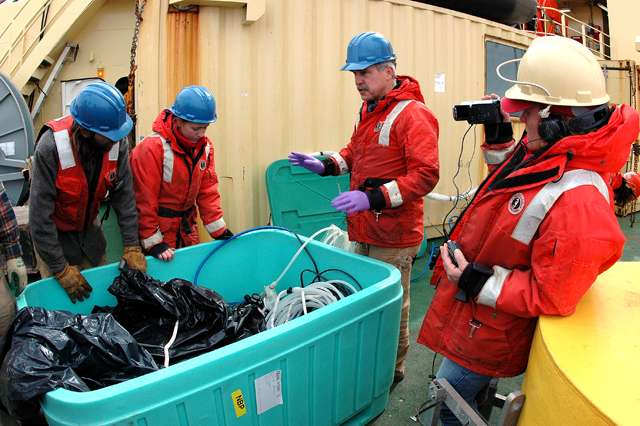Without a tracePalmer LTER adds new component to search for metals in the oceanPosted June 18, 2010
On the aft deck of the ARSV Laurence M. Gould But this is no Poe “Tell-Tale Heart” thumping below deck in accusatory anguish. Rob Sherrell’s It’s not easy finding naturally occurring trace metals like iron in the ocean aboard a ship made of metal. In fact, along this stretch of ocean near the west coast of the Antarctic Peninsula, no one has really measured the particulate and dissolved metals. Iron, in particular, is an important micronutrient that helps create phytoplankton blooms — eruptions of small, plant cells used for food by marine animals, and which are also important in the cycling of carbon in the ocean. The lack of iron is the limiting factor for phytoplankton growth in the 24-hour daylight of the Antarctic summer, explained Sherrell, a professor in the Marine Biogeochemistry & Paleoceanography Group at Rutgers University Mapping iron and other metals, like zinc and copper, is a new wrinkle for the PAL LTER program, a nearly 20-year study of the marine ecosystem along the western Antarctic Peninsula. This year’s effort is a bit of a pilot project, a small step toward a more ambitious plan to understand the role these trace elements play in the Southern Ocean system. For example, what is the spatial and temporal relationship between phytoplankton blooms and iron? Why are the blooms patchy, varying from east to west away from the shore? “We don’t even know the sources of iron,” Sherrell mused. “We’ll begin sampling to determine the sources.” One idea is that sea ice, which stretches from the shore to deeper ocean, collects particles from the atmosphere on the surface. In the summer, when the thin cover of ice melts, it dumps the iron and other trace metals into the sea. Such fertilization would create a great pulse of phytoplankton life, Sherrell said. But: “That doesn’t seem to be the case,” he said. Instead, the blooms — some large enough that the blue-green flashes of color created by these explosions of life can be seen from space — occur throughout the summer. Sea ice is likely a source of iron, he added, though probably not from the atmosphere but from the ocean below and frozen into the ice each winter. Icebergs carrying sediments may also act as mobile fertilizers. The weathering of continental rocks could also be a source, as sediment moves into the ocean shallows. The PAL LTER scientists already know that by November, in the early austral summer, phytoplankton blooms are strongest 200 kilometers offshore, the farthest extent of their study area to the west in the open ocean. The blooms then migrate farther inshore and farther south to Marguerite Bay, roughly in the middle of the peninsula. “We’re going to be interested in what iron distribution is going to look like in those areas,” Sherrell said. Another measurement he hopes to make is the ratio of zinc and copper in the iron-starved ocean. As the supply of iron peters out offshore, the concentration of these other, toxic metals in the phytoplankton biomass could increase. “It’s sort of a secondary story about iron limitation and what it does to the biogeochemical cycle of these other metals,” he said. In recent years, scientists and others interested in bioengineering a fix to global warming have suggested fertilizing the oceans with iron to help “grow” phytoplankton. Phytoplankton help prevent dissolved carbon dioxide in the ocean from getting into the atmosphere. As the plankton cells die — or are consumed as food — the dead cells fall through the ocean, carrying that carbon out of the system, potentially for thousands of years. “I’m very skeptical about it,” Sherrell said when asked about the controversial proposition. “I think the chances of getting a significant and long-term deficit in CO2 from the atmosphere by fertilizing the ocean are pretty small.” A relative newcomer to the polar science community, Sherrell seized an opportunity to first work in the Southern Ocean three years ago aboard the Swedish icebreaker Oden after the National Science Foundation (NSF) “I really wanted to come to Antarctica. There’s some really interesting oceanic problems here,” said Sherrell, whose previous work has been in more temperate waters. In addition to ambitions for expanding the trace metal study within the PAL LTER, Sherrell has his own grant from NSF for a project next season involving the Oden and the RVIB Nathaniel B. Palmer “The Palmer LTER is a good parallel to things I’m doing in the Amundsen Sea next year,” he said. “I think it will take a significantly bigger effort to sort out this problem of iron distribution and source.” NSF-funded research in this story: Oscar Schofield, Rutgers University, Award No. 0823101 |



For USAP Participants |
For The Public |
For Researchers and EducatorsContact UsU.S. National Science FoundationOffice of Polar Programs Geosciences Directorate 2415 Eisenhower Avenue, Suite W7100 Alexandria, VA 22314 Sign up for the NSF Office of Polar Programs newsletter and events. Feedback Form |


